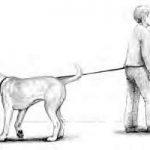- Understanding the basics of canine law
- Finding the laws that apply to you
- Playing by the rules
- Taking the bite out of dog bite law
- Preventing cruelty to dogs
We live in a litigious society. Whether or not you’ve been involved in a lawsuit, the law likely will somehow touch more than a few aspects of your life — including your canine companion. From federal laws to local ordinances, countless regulations exist to protect homeowners, neighbors, dogs, businesses, and more.
Of course, we all prefer to be on the right side of the law, but at some point you may find yourself faced with a legal conundrum. Maybe your dog barks from the minute you leave in the morning until you walk in the door for dinner — and the police are tired of getting calls from your frazzled neighbor. Perhaps your landlord has decided that your shepherd mix is a bit too big for his liking and he’s terminated the lease on your apartment. Worst of all, maybe your dog bit a neighborhood child who came into your yard to get his wayward baseball.
This chapter fills you in on some common canine legal issues — licenses, leash laws, and noise ordinances. Other laws that have to do with animal welfare, such as animal hoarding or keeping a dog chained up or locked in a car, are also covered. A relatively new issue, that of breed-specific laws against “dangerous dogs,” surfaces in the media from time to time and also merits discussion.
You shouldn’t need a law degree to share your life with a dog, but some basic knowledge, as well as an added bit of research thrown in for good measure, can’t hurt.
Discovering the Laws That Affect You
In most cases, local governments are in charge of basic animal regulations, such as leash laws and license requirements. Although these laws are similar from one city or region to the next, details may vary, so it’s worth checking when you first get a dog or move to a new town.
So how do you find out about the laws related to your dog? Start local and work your way up. Begin with one or more of these approaches:
- Contact your local animal control agency or health department.
- Ask the city clerk for a written copy of the municipal code (city ordinances), including those having to do with dogs.
- Go to the library and look up the city codes and dog laws.
- Find the codes on the city’s Web sites.
Depending on your situation, you may want to continue your research at the county level; do so by talking to the county clerk or visiting the county’s Web site.
State law varies greatly, but many sites can help you monitor both current and pending legislation in your state.
Tip
The Dog Law Web site (www.doglaw.hugpug.com) offers helpful resources and information — tenant rights, traveling issues, dog bite liability — for the average pet owner. For issues related to pet welfare, try the research tool on the site of the Humane Society of the United States (www.hsus.org/legislation_laws/state_legislation/), which tells you where your state stands on laws about everything from tethering (keeping a dog tied up) to spaying and neutering. Another online service, the Animal Law Web Center (www.animallaw.info), run by the Michigan State University College of Law, is an invaluable source of legal materials geared toward nonlawyers. With a library of cases and statutes, and content categorized into more than 50 topics, the site is a user-friendly source of information on a wide variety of animal issues.
Though most of the laws that affect pet owners are at a local, county, or state level, federal legislation does cover issues such as animal welfare and fair treatment of disabled persons who use guide dogs (see the sidebar “Protecting service dogs”).
Cracking the codeMost (but not all — Google is your friend) city and county Web site addresses follow these formats, simplifying the process of finding your local ordinances online: – County: www.co.<county name>.<state postal code>.us (as with www.co.monmouth.nj.us)
– City: www.ci.<city name>.<state postal code>.us (as with ww.ci.tulsa.ok.us).
|
Making it official: Getting a dog license
Almost no matter where you live — town, city, or village — most dogs are required to have a license. Why, you ask? Licensing helps protect all of us from rabies, because dogs must have proof of the rabies vaccination before they can be licensed. Plus, the identification tags that go along with a license help get lost or stray dogs returned to their owners. Getting your dog licensed is a fairly simple process when you follow these steps:
1. Have your dog vaccinated for rabies (usually at around 4 months of age); get proof of the vaccination from your veterinarian.
2. Fill out the required application, typically with the city or town clerk. Have your proof of vaccination with you.
3. Pay the fee. Annual fees run about $10 to $20, but they are generally less for spayed and neutered dogs (bring proof from your vet). Some cities are now raising fees for unaltered animals, to encourage owners to spay and neuter. In most cases, fees are waived for guide and service dogs, as well as waived or reduced for the dogs of senior citizens and disabled persons.
4. Attach the license tag to your dog’s collar; file the paper license with your legal paperwork.
5. Renew your dog’s license when necessary; most agencies send renewal notices.
Of course, a license won’t do much good if you don’t renew it every year or you don’t keep the tag on your dog at all times. Without a tag, an animal control officer may be forced to take your lost pup to the animal shelter.
Vaccinating your dog
Most veterinarians agree that certain vaccines are necessary, but laws and practices may vary, so check with your vet about the vaccination schedule she recommends. The most common vaccines are parvovirus, distemper, rabies, and adenovirus. Although the disease is rare, your dog will need a rabies vaccination to be licensed. Check with your town or city about vaccination requirements and any free or low-cost clinics that are offered.
Spaying and neutering
With millions of unwanted pets, and shelters and rescues overwhelmed, a logical solution is to encourage owners to spay and neuter. In fact, most states now require people who adopt dogs from a shelter to spay or neuter them, a measure that may have a limited effect on the problem but is a good move nonetheless.
But what about those unaltered dogs who are already breeding — intentionally or accidentally — in the general dog population? A few cities are taking a more drastic approach, requiring spaying or neutering of all pets unless the owner buys a special breeding permit each year. The tactic is controversial among some people, but it may help reduce the number of unwanted pets in this country.
Protecting service dogsService animals are dogs who are trained to perform tasks for people with disabilities — guiding the blind, alerting the deaf, pulling wheelchairs, or performing other special tasks. Because service animals are working animals, not pets, they have special rights in the world of canine law. Although a restaurant won’t likely welcome the typical dog, under the Americans with Disabilities Act (ADA), a federal law, “businesses and organizations that serve the public must allow people with disabilities to bring their service animals into all areas of the facility where customers are normally allowed to go.” This applies to restaurants, schools, hotels, taxis, grocery and other stores, hospitals, theaters, health clubs, parks, and even zoos. Other special considerations are also made under the ADA, including allowing service dogs to live in housing with “no pets” policies. In addition, in many cases, local ordinances about licensing and even pooper-scooping don’t apply to assistance dogs. |
Staying Out of Trouble
A bit of common sense goes a long way when it comes to keeping you and your pup out of trouble. Nuisance laws — those laws that prohibit constant barking and require that owners clean up after their dogs — are among the most common you’ll come across. To reduce your dog’s chance of being a nuisance, do the following:
– Use a leash and put up a fence. If your dog is safely secured in your yard or on a leash, he can’t bother anyone or harm someone’s property. The day you make an exception may be the day your pooch decides to dig up your neighbor’s flower garden.
– Spay or neuter your dog. Your dog may behave better and wander less. Careful breeding programs are one thing; random neighborhood couplings are another. See the earlier section, “Spaying and neutering.”
– Socialize early and often. From an early age, expose your dog to lots of people — children, too. Your friends, family, and neighbors will appreciate not being nibbled on, barked at, or jumped on.
– Try training. Even if you don’t have any aspirations of owning an obedience champion, training your dog to walk on a leash and follow the basic commands of Sit, Lie Down, and Stay may mean the difference between a well-behaved dog and one who can’t be trusted with company.
– Leave no trace. Always pick up what your dog leaves behind. Grab a plastic grocery bag or use a fancy sack — just pick up the poop and dispose of it properly.
– Prove that your dog is good. The American Kennel Club offers a certification program designed to reward dogs “who have good manners at home and in the community.” See Chapter Teaching Your Dog Manners for more on doggie manners.
Read on to find out more about the legal implications of the common nuisance laws.
Taking care of business: The scoop on poop
Like everyone, dogs poop — it’s a fact of life. But it wasn’t until more of us starting living in cities with our dogs that the canine byproduct became a real problem. It doesn’t take long for a sidewalk to become littered with dog feces when owners don’t pick up after their pooches. And no one — no one — enjoys stepping on the stuff.
In the 1930s, New York City was an early battleground in the war against doggie doo. “Please Curb Your Dog” signs were minimally effective, but in 1978, New York State’s Canine Waste Law (commonly called the “poopers-cooper law”) went into effect; the law called for the removal of canine waste in any city with a population of 400,000 or more. Since then, cities and towns of all sizes have followed suit.
Warning!
Still don’t feel like picking up after your dog? Expect to pay a fine of anywhere between $25 and $100.
Leash laws
It would seem that laws about leashes have to be among the simplest on the books, simply because it makes good sense for dogs be leashed when they’re off their owner’s property. Not so. Although many of us assume that all states have a mandatory leash law, it’s not likely to be the case. To complicate matters, some municipalities have leash laws and some don’t, so it’s important to look into your local regulations.
Tip
Check out www.animallaw.info/articles/ovusdogleashlaws.htmfor a break-down of the states’ widely varying leash laws.
A typical leash law requires dogs to be leashed and under control when they’re off their owner’s property. This means that the days of letting a dog run loose in the neighborhood are over, and your dog should be walked on a leash even if you’re confident that she’s completely off-leash trained. Unleashed dogs can get loose and run the risk of being hit by a car or picked up and taken to an animal shelter; owners are liable for fines, as well as any legal actions — say, if a loose dog bites someone.
Try to find a local dog park for a safe place to let your dog run free. Like playgrounds for pooches, dog parks are popping up in communities throughout the country.
Noise ordinances
Anyone who’s ha d to put up with a barking dog for more than a few minutes can attest to the level of piercing annoyance it causes. It’s not a surprise that noise complaints are among the most common lodged against dogs and their owners. Though such complaints are usually resolved between individuals and rarely end up in a courtroom, laws help protect neighbors from the headaches and sleepless nights caused by a chronic barker.
Resolving disputes: Giving peace a chanceIf you end up in the middle of a neighborly dispute about a dog (yours or the neighbor’s), first try to talk through the problem. Even if it doesn’t work and you end up in a court of law, you’ll know you tried to be civil. Consider some tips: – Try it in writing — write a friendly note to set up a meeting and get the ball rolling.
– Be calm and listen.
– Don’t threaten to call the police or a lawyer.
– Offer solutions and listen to those offered to you.
– Agree on a plan and then schedule a date to meet again for a progress check.
If you can’t resolve the issue, you may have to bring in some help — a mediator, perhaps. Of course, if all else fails, you may need to do your research to find out your legal rights. |
In many cases, specific state laws or local ordinances cover the problem of barking dogs. When a law isn’t specifically geared at dog noise, a general noise ordinance usually does the trick; most local noise ordinances designate quiet hours from 10 p.m. to 7 a.m., so anyone allowing their dog to bark, howl, or whine during those hours can be charged with disturbing the peace.
When a barking dog becomes a real problem, it’s best for everyone (you, the neighbor, and the police) to resolve matters without involving the police or animal control. See the nearby sidebar, “Resolving disputes: Giving peace a chance,” for tips. When all else fails, though, you may have to check your local and state laws and pursue a legal avenue.
Biting
Although the majority of dogs are harmless, the statistics for dog bites are startling. The Centers for Disease Control and Prevention estimate that 4.7 million people are bitten by dogs each year, with about 800,000 — half of them children — requiring medical attention.
Warning!
Regardless of breed or prior history, even the friendliest dog may bite. A bite is a bite, whether the dog was provoked, afraid, hurt, acting on a natural instinct to be protective, or even being playful. In short, people win. And under many laws, owners may be held financially liable when their dog hurts someone. This is no small matter. According to the Insurance Information Institute, the average cost of a dog bite claim was $24,461 in 2008.
Laws vary, so it’s a good idea to determine the type of dog bite law imposed in your state. About two thirds of the states have what is known as a
strict liability statute, which makes the owner liable for any personal injury caused by a dog, regardless of the owner’s knowledge of viciousness. This means that a victim has a valid case against the owner even if a dog has never bitten anyone. Some exclusions may apply, such as some that pertain to whether a dog was provoked or questions on whose property the bite occurred. Go to
www.animallaw.info/articles/qvusdogbiteslstatutes.htmto see specifics about each state’s statute.
Some states follow the common-law doctrine of the “one bite” rule, which basically means that a dog owner can be held liable for any injury if he had knowledge of any vicious tendencies. However, an owner may be deemed liable after a dog has bitten the first time or if the victim can prove negligence (a fence wasn’t high enough to secure a dog, for example). Many states have switched from this law to the strict liability statute.
In many states, cases that involve breeds considered “dangerous” — mainly the Pit Bullish breeds — are handled differently. Often these dogs are bred or trained to be aggressive. For more on the issue of breed-specific law, see the section “Regulating Dangerous Dogs.”
Keeping in mind that any dog may bite, you can take measures to help prevent a bite from happening:
– Never let your dog run loose. Secure fencing and leashing are critical.
– Socialize and train your dog from an early age.
– Spay and neuter your dog to help reduce aggressiveness.
– Carefully monitor contact with children — insist on considerate behavior, and never leave a dog alone with a child.
Regulating Dangerous Dogs
Even the sweetest dogs can snap (literally and figuratively) under certain circumstances, but individual dogs who do bite someone or display dangerous tendencies are, from then on, considered “dangerous” or “vicious,” according to some laws. Although most dangerous dog laws are found at the local level, a number of states are now adopting versions of such laws.
Although no federal anticruelty law is on the books, every state in the nation has an animal anticruelty statute that applies to dogs. These state laws penalize two types of actions:
– Intentional acts: Hitting, burning, maiming, or killing a dog
– Failure to act: Situations of neglect in which food, water, veterinary care, and shelter are not provided to a dog
Tip
The laws vary greatly, however, with some much stronger and more encompassing than others. The Humane Society of the United States features a way you can review your state’s animal cruelty laws: www.hsus.org/acf/cruelty/publiced/animal_cruelty_laws_by_state.html. The organization also offers information on some of the common issues related to dog welfare.
Breaking free from the chains
A truly sad and unfortunate sight is that of a dog chained to a stake in a patch of dirt in the middle of someone’s backyard. The dog is lonely, bored, frustrated, frightened, and maybe even thirsty and hungry.
Tethering — tying or chaining a dog to a stationary object for an extended period of time — is inhumane and can cause serious problems, such as aggression and psychological damage. Tethered dogs also suffer from biting insects, extreme temperatures, and sun exposure; tragically, many dogs have been strangled to death by tethers.
Fortunately, tethering is becoming increasingly recognized as an unnecessary act of animal cruelty. In fact, according to the Humane Society, more than 100 communities in more than 30 states have passed laws that regulate the practice of tethering animals. Other communities allow tethering for only limited periods of time.
If dogs are to be left outside during the day, they need a securely fenced outdoor pen or other space that has a shelter to protect them from the elements. And all dogs should be taken indoors at night. The only object your dog should be attached to is the leash you use on his daily walks.
Dogs in vehicles
Cars and dogs have a love-hate relationship: Dogs love to chase cars and ride with their noses poked out of car windows; unfortunately, they are too often injured or killed in or by cars. Dog lovers have worked hard to get anticruelty laws passed to protect pooches when it comes to automobiles:
– Parked cars: An enclosed car can heat up fast on a warm, sunny day, with the temperature exceeding 100 degrees Fahrenheit in just minutes. Don’t be fooled into thinking that your dog will be fine if you park in the shade or crack a window or two. Anticruelty statutes and laws forbid owners from leaving a dog in a parked vehicle without adequate ventilation.
– Pickup trucks: Approximately 100,000 dogs a year are killed in the United States because they jump or are thrown from the open back of a pickup truck. Many local governments and some states — California to name one — have adopted laws that require dogs to be in cages or otherwise secured in truck beds.
Setting limits on numbers
To protect both animals and residents, some communities have put into place ordinances that restrict the number of dogs residents can have, usually to two or three per household. Many times these laws are created to cut down on the problems of noise and odor that can be caused by high concentrations of canines. In some cities, owners can pay for a special permit that allows them to keep more dogs.
Animal hoarders, people who collect animals beyond their ability to provide for the animals’ needs, are at the extreme end of the spectrum — but of special concern to anticruelty organizations. These are the cases that occasionally surface in the media; the abuse typically differs from other types of cruelty because the hoarders themselves can’t or don’t see the problem, many times because they are suffering from some sort of psychological issue such as obsessive-compulsive disorder.
by Eve Adamson, Richard G. Beauchamp, Margaret H. Bonham, Stanley Coren, Miriam Fields-Babineau, Sarah Hodgson, Connie Isbell, Susan McCullough, Gina Spadafori, Jack and Wendy Volhard, Chris Walkowicz, M. Christine Zink, DVM, PhD


































